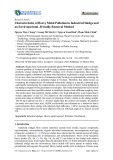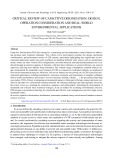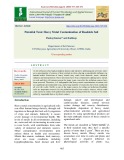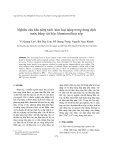
Heavy metal removal
-
This study determined the heavy metals enrichments and their possible sources in industrial sludges from different sampling time. The results show that industrial sludge exhibits very high pollution for some typical heavy metals, especially Cu and Cd.
 10p
10p  viyoko
viyoko
 01-10-2024
01-10-2024
 1
1
 0
0
 Download
Download
-
Capacitive Deionization (CDI) has emerged as a promising and environmentally sound solution for addressing pressing water treatment challenges. This critical review meticulously examines the design, operational considerations, and performance metrics of CDI systems, particularly highlighting their significance in environmental applications under real-world conditions for handling different water sources such as groundwater, surface water, sea water.
 22p
22p  vifaye
vifaye
 20-09-2024
20-09-2024
 1
1
 1
1
 Download
Download
-
A series of blends consisting of Red mud(RM) varying from 1.5 to 3 g and Graphene oxide(GO) varying from 0 to 1.5 g to give a total of 3g were prepared.
 10p
10p  lucastanguyen
lucastanguyen
 01-06-2020
01-06-2020
 8
8
 2
2
 Download
Download
-
As the urban area has high population density and intensive anthropogenic activities, there are a great number of sources of heavy metals in cities, placing a considerable influence on human health. Emissions of heavy metals may come from domestic waste, chemical industry and transportation. These emissions have been continuously adding heavy metals to soils and they will remain present for many years even after the pollution sources have been removed.
 7p
7p  nguaconbaynhay5
nguaconbaynhay5
 16-05-2020
16-05-2020
 22
22
 0
0
 Download
Download
-
The increasi1ng level of heavy metals in the water environmental represents a serious threat to human health and ecological systems. These contaminants must be removed from water resources. Various treatment technologies have been developed. In this paper, the potential of removing heavy metals from aqueous solution by using porous aluminosilicate was studied. The solid sorbents were synthesized by reaction of sodium silicate and alumino sulfate with sol-gel method.
 5p
5p  tuanlocmuido
tuanlocmuido
 13-12-2012
13-12-2012
 61
61
 7
7
 Download
Download
-
Toxic heavy metals, i.e. copper (II), lead (II) and cadmium (II), can be removed from water by metallurgical solid wastes, i.e. bauxite waste red muds and coal fly ashes acting as sorbents. These heavy-metal-loaded solid wastes may then be solidified by adding cement to a durable concrete mass assuring their safe disposal. Thus, toxic metals in water have been removed by sorption on to inexpensive solid waste materials as a preliminary operation of ultimate fixation. Metal uptake (sorption) and release (desorption) have been investigated by thermostatic batch experiments.
 11p
11p  tudoia
tudoia
 06-04-2011
06-04-2011
 118
118
 8
8
 Download
Download
CHỦ ĐỀ BẠN MUỐN TÌM


















